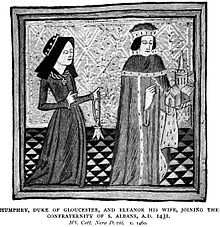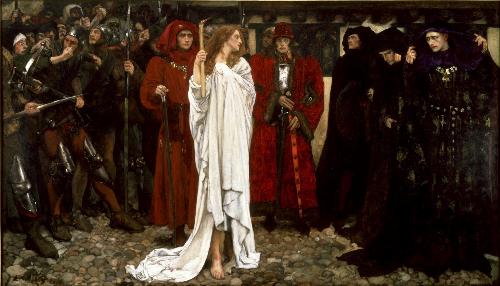 Eleanor Cobham, Duchess of Gloucester (c.1400 – 7 July 1452), was the mistress and then second wife of Humphrey, Duke of Gloucester, the youngest son of King Henry IV. Eleanor was convicted and imprisoned for ‘sorcery’ and ‘treasonable necromancy’ in 1441 and forced to make a public penance in the streets of London – all this from a woman who came within a breath of being the Queen of England..!
Eleanor Cobham, Duchess of Gloucester (c.1400 – 7 July 1452), was the mistress and then second wife of Humphrey, Duke of Gloucester, the youngest son of King Henry IV. Eleanor was convicted and imprisoned for ‘sorcery’ and ‘treasonable necromancy’ in 1441 and forced to make a public penance in the streets of London – all this from a woman who came within a breath of being the Queen of England..!
The daughter of a minor noble, Eleanor was brought to court in 1422 to become a lady-in-waiting to the newly arrived Jacqueline – whose impressive array of titles included Duchess of Bavaria-Straubing, Countess of Holland and Zeeland and Countess of Hainaut. Jacqueline was fleeing a disastrous marriage and was hoping that the English might help her wrest control of her territories back from her useless husband.
After the sudden death of Henry V and ascension of the infant Henry VI, Jacqueline fudged a divorce from her husband on the grounds of consanguinity and married the new king’s uncle and Lord Protector, Humphrey – the Duke of Gloucester – and so it was that her lady, Eleanor Cobham, came into his sphere. A well matched pair, the Duke and the lady became lovers in 1425.
Both attractive, pleasure-loving and ambitious people, they openly flaunted their relationship whilst poor abandoned Jacqueline languished on the continent. Humphrey was known to have had two illegitimate children – the wonderfully romantically named Arthur and Antigone Plantagenet – Eleanor could well have been their mother, but if she was it is rather likely that Humphrey would have retrospectively legitimised them after their legal marriage took place.
In 1428 the Pope ruled that Jacqueline and Humphrey’s marriage was invalid – she hadn’t exactly dotted her i-s and crossed her t-s when it came to her ‘annulment’ from her first husband. Luckily for Jacqueline, her ex was by then dead, and so there was absolutely nothing stopping Humphrey from marrying her again and making everything legit. Except Humphrey married Eleanor Cobham.
The new Duchess wasted absolutely no time making sure everybody understood her new status. She rode through the streets of London dressed up to the nines and accompanied by so many men at arms you would have been forgiven for assuming she was someone far more important than she actually was. Her contemporaries remembered her as proud and prickly – although the young Henry VI seems to have been fond of his aunt and gave her many presents.
In 1435, Humphrey’s elder brother the Duke of Bedford died, which made Humphrey the heir presumptive to the still-young and childless Henry VI. Now this knight’s daughter made good was heir to the Queenship of England!
The house of cards came tumbling down in 1441. A group of men were arrested for using ‘astrological predictions’ to forecast that Henry VI was soon to suffer a life-threatening illness. The men admitted their treason, but swore they had only done what they did on the instigation of the Duchess of Gloucester, who had hankered to know if it was likely her husband would ever sit on the throne.
A panicked Eleanor fled to Westminster, claiming sanctuary. She might have hoped that her high status would save her from trial for treason; she was right, but nothing could stop the ecclesiastical courts trying her for witchcraft and heresy. A thorough investigation into Eleanor’s life and movements threw up more damning evidence. A known ‘witch’ – Marjorie Jourdemayne – said that in the 1420s Eleanor had contracted her to produce love potions that would make the Duke of Gloucester marry her. Eleanor denied this, claiming that the potions had been to help her conceive. Nevertheless, she was found guilty, as were her co-conspirators, who were hung, drawn and quartered or burned.
The Duchess’ sentence was a forcible divorce from her husband, and a public penance through the streets of London before going on to life imprisonment. On a cold November day, shamefully bareheaded and dressed simply in black, Eleanor walked from Temple Bar to St Paul’s Cathedral, where she offered up the wax taper she had carried to the alter. Two days later she did the same from Swan Pier to Christ Church, and then for a third time from Queenhithe to St Michael’s. Each time there was a large crowd on hand to witness her disgrace and humiliation, eerily silent – they had been ordered not to molest the former Duchess, but neither were they to show her any respect. Eleanor spent the last decade of her life imprisoned in various castles. It wasn’t all bad – the soft-hearted Henry VI still sent her presents, and allowed her 100 marks a year and a household of twelve people!
Although he must have once loved Eleanor fiercely, Humphrey never attempted to come to her rescue. Perhaps frightened of implicating himself, and all too aware of the great tensions around the Lancastrian court, Humphrey said nothing. He died in 1447 – apparently due to a stroke, although murder was rumoured at the time. Posthumously – and probably in relation to the growing hard-feelings against Henry VI and his ministers – he became known as ‘Good Duke Humphrey’. Eleanor was neatly forgotten about – we didn’t know her date or even place of death until the 1970s.
In the end, Eleanor’s legacy would be as the catalyst for a change in the law. A year after her trial, Parliament declared that peeresses charged with treason were to be judged in the same way as everyone else – unfortunately for Queens such as Anne Boleyn and Catherine Howard, a hundred years or so later.
So, was Eleanor Cobham a witch? Nope. It was a fashionable court pastime to dabble in potions and predictions – not exactly accepted, but pretty normal. Eleanor was unfortunate in that she lived in a treacherous political climate that was soon to result in the War of the Roses, she wasn’t well liked, and her husband was – to some – a political liability. It wasn’t quite a stitch-up as she was technically guilty – but she was certainly the victim of political intrigue.



Thanks for posting a balanced account – now posted on my facebook page https://www.facebook.com/eleanorcobham